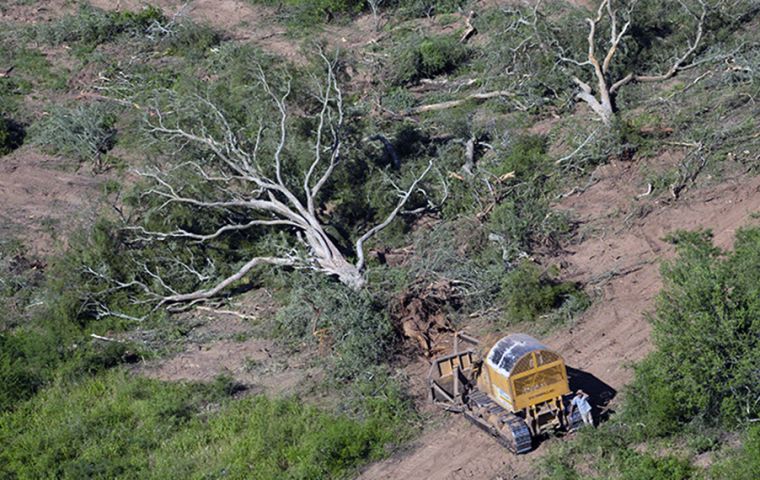MercoPress. South Atlantic News Agency
NGOs claim most deforestation in northern Argentina during 2021 was illegal
 Corruption plays a big part in deforestation, it was reported
Corruption plays a big part in deforestation, it was reported Around 110,180 hectares of forest were destroyed in the Argentine provinces of Santiago del Estero, Formosa, Chaco, and Salta during the year 2021 as a result of illegal practices, according to Greenpeace.
“It means more climate change, more floods, more evictions of peasant and indigenous communities, more disappearance of endangered species and more diseases,” the NGO warned.
The organization said 52,290 hectares were hit in Santiago del Estero; 29,165 in Formosa; 18,068 in Chaco and 10,657 in Salta or -in other words- five times the surface of the city of Buenos Aires were subject to these practices, according to Greenpeace's annual report, which also warned about an “increase in illegal deforestation in northern Argentina.”
The document also pointed out almost half of the deforestation occurred in Santiago del Estero, of which over 80% was illegal, a number which was found to be on the rise from 50% in previous years.
Greenpeace's Hernán Giardini explained that behind this phenomenon in Santiago del Estero was a considerable expansion of livestock breeding. The province “has been doing it for a long time and authorizes selective clearing, supposedly sustainable, but in the long run it is clearing in stages.”
He added that “sometimes the maps for the expansion of cattle ranching in the north do not coincide with the maps that the provinces themselves have for caring for the forest.”
In the case of Chaco, a court ruling in November 2020 ordered the suspension of clearing permits until its Territorial Planning of Native Forests was updated, despite which deforestation continued. “More than 18,000 hectares of clearing is a lot for a province where the justice system said that they did not have to clear any more until they had a new planning map. This shows that not even justice can stop it if there are no tools. The penalty is half inevitable, beyond the fact that later everything that implies deforestation can be discouraged,” said Giardini.
The phenomenon is not new, but its persistence over time only aggravates it. According to the Food and Agriculture Organization of the United Nations (FAO) Argentina ranked among the ten countries that deforested the most between 1990 and 2015: 7.6 million hectares were lost, at a rate of 300,000 hectares per year, while data from Argentina's Environment Ministry showed that between 1998 and 2020 the loss of native forests in the country was close to 7 million hectares.
The figures released in the 2021 report, alarming in themselves, do not take into account the effects of forest fires. The study is based on the comparison of satellite images, but the process is more complex if burned down areas were to be analyzed.
“Although since 2014 there has been a decrease in deforestation, half of the clearings are carried out where it is not allowed. In 2020 there was a significant growth in the loss of forests, due to the large number of fires,” Greenpeace's report points out. It also highlights that fines do not seem to work as a deterrent to those responsible for these malpractices, mainly because they do not even pay those monetary penalties.
Greenpeace's 2021 report showed something which has been growing over time and went worse amid a global pandemic and increasingly noticeable climate crisis. “We have been monitoring [it] for more than 6 years, and with the pandemic there was not much decrease. The trend is still more or less stable. And we do see an increase in illegality and there is concern at that point. The climate crisis situation forces us to think not only about what is illegal, but about zero deforestation in the future,” Giardini told Tiempo Argentino.
In January 2022, with temperatures averaging 43º Celsius in Resistencia (Chaco), the organization Somos Monte released several videos of trucks loaded with fallen trees as the result of tannin production. The group also stressed that in October “the Tyrol and La Escondida tannin companies had admitted in a trial“ that they used quebracho trees from clearings, which involved the new biomass plants falsely painted as clean.
Every year 80,000 tons of quebrachos several centuries old were taken from the Impenetrable forest at a rate of 6 trucks per day, 365 days a year, each truck carrying around roughly 35 tons of trees.
“Faced with the climatic collapse that we are experiencing these days -I live in the countryside I realize what you are suffering- and faced with the shameful failure of the Forest Administration Directorate in the province, the only response so far from the government is the silence. They do not answer requests for reports, they do not give access to complaints. Nation, on the other hand, yes. Here the authorities refuse a constructive debate. The strategy is to silence the environmental movements that talk about clearing,” said Dardo Tiddi, from Somos Monte Chaco.
He added that corruption played a big role in these actions. ”We are doing what the forest authorities do not want to do: we are controlling illegal clearing, burning, denouncing in the media because we are given no other alternative. And in court when we are given the opportunity. We have two very serious trials, one with a lower court sentence. We have a territorial code that expired eight years ago. And we find ourselves facing powers such as the tannin companies, who want to increase what they want to dismantle.”
(Source: Tiempo Argentino)




Top Comments
Disclaimer & comment rulesCommenting for this story is now closed.
If you have a Facebook account, become a fan and comment on our Facebook Page!